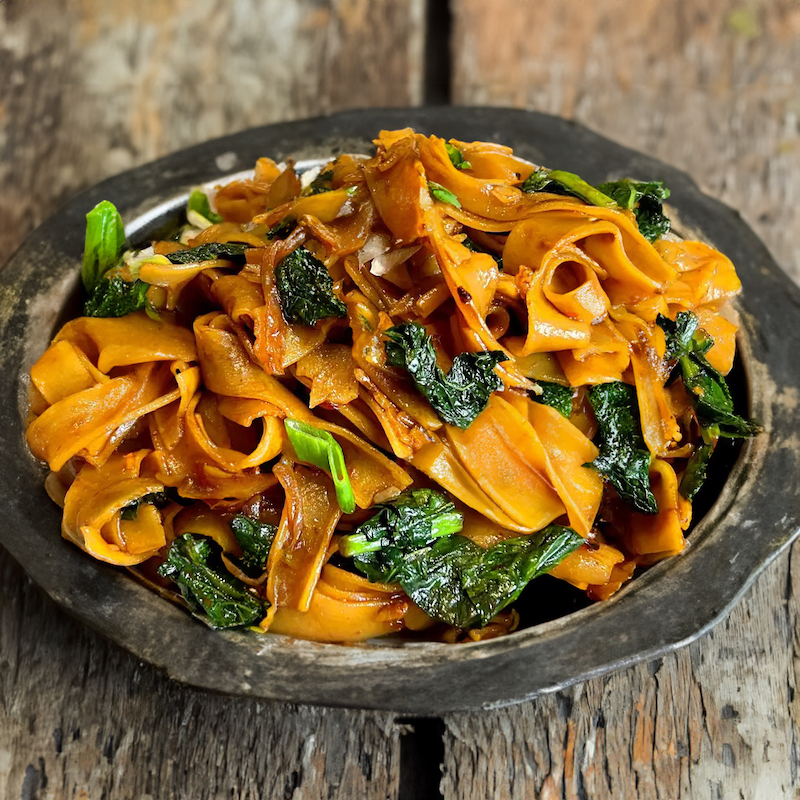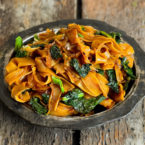Jessica Smith is a native of the American Midwest, currently…
Sometimes, kid-friendly dishes become adult favorites as well. One of those dishes is the beloved Thai classic, Pad See Ew. This easy version of the popular Thai noodle dish uses only a few ingredients and takes less than 20 minutes to prepare.
“It’s kid food!” is a response I often receive from Thai friends when I profess my love for Pad See Ew. I consider it a compliment. True, the classic pan-fried noodle dish is not spicy or particularly complex. It is simple, satisfying comfort food. And after all, I rationalize, some of the most kid-friendly foods are equally (and justifiably) loved by adults. I rank Pad See Ew among the best of them.
Many Thai recipes are not for the faint of heart. There are more than a few popular dishes that are well worth ordering from a local Thai take-out spot rather than trying to make them at home. Often the challenge stems from the use of ingredients that are not readily available in most markets in the world. In addition, Thai soups and curries can require an investment of time to develop flavors and bring out the signature balance of salty, sour, sweet, bitter, and spicy. Even most Pad Thai recipes call for 15 or more ingredients.
Fortunately, Pad See Ew is not one of those dishes. In fact, it is one of the most quick and rewarding Thai meals to make at home. At its most basic, it requires preparing a mere six ingredients (plus oil) and 5 minutes at the stove. The most important thing to keep in mind is to crank up the heat when cooking. A very hot wok gives the noodles a bit of caramelization and heats them all the way through before they soften. I have watched vendors in Thailand prepare a serving of Pad See Ew in under 60 seconds over a scorchingly hot wok.
The recipe below is a basic, no-frills, vegetarian Pad See Ew, but it is endlessly variable. Here are a few suggestions for substitutions and additions to get you started on making it your own.
Substitutions and Additions
Noodles
In Thailand (and in Thai restaurants around the world), Pad See Ew is typically made with fresh, wide rice noodles. However, it can easily be prepared with thin, dry noodles, commonly called “rice-stick”. If using dried noodles of any width, simply drop the noodles in boiling water until slightly tender. Remove from the boiling water and rinse under cool water to stop the cooking process. Drain them very well and use them as a substitute for the wide rice noodles in the recipe below.
Sauce:
Soy sauce is the key element of the sauce in Pad See Ew. In Thailand it is common to use a light soy sauce combined with a thicker, slightly sweet soy sauce (sometimes called a “seasoning soy sauce”). However, the more common Japanese soy sauces (of the type served in most sushi restaurants) will work just as well. Palm sugar is used to add sweetness to the sauce, but granulated sugar can be used as a substitute. Regardless of the type of soy sauce or sugar used, the sauce can be easily adjusted for your preference in balance between salty and sweet.
Protein:
Pad See Ew makes an excellent vegetarian dish, but easily benefits from an addition of egg or a few slices of firm tofu, chicken or pork. Regardless of the protein used, it should go into the hot wok after the shallot and should be fully cooked through before adding the sauce.
Vegetables/Greens:
Often Pad See Ew is made with just a handful of fresh basil leaves, but other greens such as Chinese kale make an excellent addition. More hearty vegetables like broccoli florets are also a great choice, but do best if treated like the proteins described above (cooked until tender in the hot wok before the sauce is added).

How to Make Pad See Ew
Make the Sauce Mixture:
In a small bowl, whisk together the minced garlic, palm sugar, and light soy sauce. Set this aside for later use to flavor the noodles.
Heat the Pan:
Warm the vegetable oil in a wok or large frying pan over medium-high heat. Make sure the oil spreads evenly to coat the bottom.
Sauté Shallot:
Add the sliced shallot to the hot oil, cooking it until it just begins to soften. This should take about 30 seconds. The shallots should not brown too much but just become translucent.
Add Sauce:
Pour the prepared sauce into the wok with the shallots. Wait for the sauce to start bubbling. If your pan was hot enough, this should happen almost immediately.
Incorporate Noodles and Basil:
Gently add the noodles to the wok, followed by the basil leaves. Use tongs or a spatula to toss the noodles in the sauce, ensuring they’re evenly coated. Keep stirring to prevent the noodles from sticking to the bottom of the pan.
Cook Until Done:
Continue cooking until the basil has wilted and the noodles have a nice char on some edges. This should take around 2-3 minutes. The high heat will help achieve that slightly smoky flavor typical of Pad See Ew.
Final Touches:
Once the noodles are cooked and well-coated with the sauce, remove the pan from the heat. Your Pad See Ew is now ready to be served.
Plate Your Dish:
Serve the Pad See Ew hot, straight from the wok for the best flavor and texture. You can garnish with additional fresh basil leaves if desired.
Recipe Notes:
- If you’re adding protein such as chicken or tofu, cook it in the pan before the shallots and set aside, adding it back in with the noodles.
- For an authentic touch, serve with a side of lime wedges and extra chili flakes or soy sauce.
Cooking Tips:
- High heat is crucial for stir-frying, as it cooks the ingredients quickly while retaining their texture.
- If the noodles start to stick, a splash of water or extra soy sauce can help loosen them without compromising the flavor.

Easy Pad See Ew
5 Stars 4 Stars 3 Stars 2 Stars 1 Star
5 from 11 reviews
- Author: Jessica Smith
- Total Time: 20 minutes
- Yield: 2-3 1x
Description
Sometimes, kid-friendly dishes become adult favorites as well. One of those dishes is the beloved Thai classic, Pad See Ew. This easy version of the popular Thai noodle dish uses only a few ingredients and takes less than 20 minutes to prepare.
Ingredients
- 1 clove garlic, minced
- 3 tsp. palm sugar
- 3 Tbsp. light soy sauce
- 2 Tbsp. vegetable oil
- 1 small shallot, thinly sliced
- 12 oz. (340 g) fresh, wide rice noodles (about 2 cups packed)
- 20 leaves fresh basil
Instructions
- Prepare the Sauce: In a small bowl, combine the minced garlic, palm sugar, and soy sauce. Whisk until well mixed and set aside for later use.
- Sauté Shallot: Heat the vegetable oil in a wok or large frying pan over medium-high heat. Add the thinly sliced shallot to the oil and cook for about 30 seconds, just until it starts to soften.
- Cook with Sauce: Pour the previously prepared sauce into the wok with the shallot. Heat until the sauce begins to boil, which should occur almost immediately if the wok is properly heated.
- Add Noodles and Basil: Introduce the fresh rice noodles and fresh basil leaves to the wok. Stir everything vigorously, ensuring the noodles are fully coated in the sauce. Cook until the basil wilts and the noodles begin to get a slight char on the bottom, about 2-3 minutes.
- Serve: Once the noodles are well coated and slightly crisped, remove the wok from heat. Serve the Pad See Ew immediately while hot.
Notes
- If using dry rice noodles instead of fresh, use 6 oz. (170 g) and boil them until tender. Rinse and drain thoroughly before adding them to the wok.
- For extra protein, consider adding egg, chicken, or tofu to the wok along with the noodles.
- Adjust the heat level by adding a bit of chili if desired, tailoring the dish to your preferred spice level.
- Prep Time: 10 mins
- Cook Time: 10 mins
- Category: Side Dish
- Method: Wok
- Cuisine: Thai
Jessica Smith is a native of the American Midwest, currently living in Thailand where she writes about food and travel throughout Southeast Asia. Jessica believes that the best way to understand a place is through its local cuisine.




Pad See Ew is my favorite dish to order at Thai restaurants. I’d love to try making it myself – hoping I can find the palm sugar and wide rice noodles.
i love thai food! i’ve never tried making this though. looking forward to it. :) thanks for sharing! bookmarking this!
I added some chicken, and it turned out perfectly. This will be my go-to recipe from now on.
Turned out amazing, and I feel like a pro now. Thank you so much!
OMG!!! This Pad See Ew recipe is LIFE-CHANGING. I’ve never made anything this delicious at home.
can’t wait to reproduce this fave take-out
This is delicious! (And much simpler that I would had imagined!)
I love this dish at Thai restaurants, and I was nervous I would mess it up. But it turned out so deliciosu and I am so happy to have found this recipe.
I doubled the soy sauce and garlic for extra punch. Fantastic base recipe, thanks for posting!
Made this for dinner last night, and it was a hit! Super easy to follow. Thanks for sharing!
This is really very much a new favorite of mine to make at home. No need for take out anymore!!